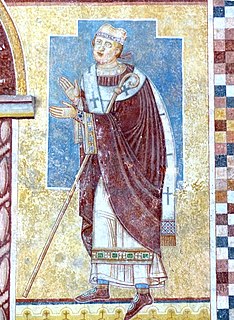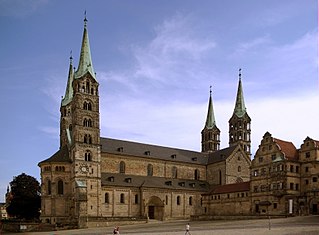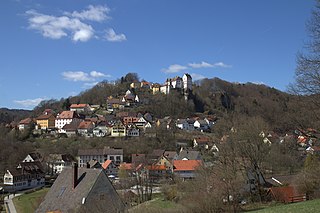Related Research Articles

Bamberg is a town in Upper Franconia, Germany, on the river Regnitz close to its confluence with the river Main. The town dates back to the 9th century, when its name was derived from the nearby Babenberch castle. Cited as one of Germany's most beautiful towns, its old town has been a UNESCO World Heritage Site since 1993, with Bamberg being home to Europe's largest intact old city wall.
Pope Clement II, was bishop of Rome and ruler of the Papal States from 25 December 1046 until his death in 1047. He was the first in a series of reform-minded popes from Germany. Suidger was the bishop of Bamberg. In 1046, he accompanied King Henry III of Germany, when at the request of laity and clergy of Rome, Henry went to Italy and summoned the Council of Sutri, which deposed Benedict IX and Sylvester III, and accepted the resignation of Gregory VI. Henry suggested Suidger as the next pope, and he was then elected, taking the name of Clement II. Clement then proceeded to crown Henry as emperor. Clement's brief tenure as pope saw the enactment of more stringent prohibitions against simony.

Otto of Bamberg was Bishop of Bamberg and a missionary who, as papal legate, converted much of medieval Pomerania to Christianity.

The Prince-Bishopric of Würzburg was an ecclesiastical principality of the Holy Roman Empire located in Lower Franconia west of the Prince-Bishopric of Bamberg. Würzburg had been a diocese since 743. As definitely established by the Concordat of 1448, bishops in Germany were chosen by the canons of the cathedral chapter and their election was later confirmed by the pope. Following a common practice in Germany, the prince-bishops of Würzburg were frequently elected to other ecclesiastical principalities as well. The last few prince-bishops resided at the Würzburg Residence, which is one of the grandest baroque palaces in Europe.

Lothar Franz von Schönborn-Buchheim was the Archbishop-Elector of Mainz from 1694 to 1729 and the Bishop of Bamberg from 1693 to 1729. As Archbishop of Mainz, he was also Archchancellor of the Holy Roman Empire. Lothar Franz von Schönborn is known for commissioning a number of Baroque buildings, such as the palace Schloss Weissenstein.

The Archdiocese of Bamberg is a diocese of the Roman Catholic Church in Bavaria and is one of 27 Roman Catholic dioceses in Germany. About a third of the population is Catholic. With 15.6% this diocese has one of higher (relative) numbers of worshippers on Sunday in Germany. It comprises the majority of the administrative regions of Upper Franconia and Middle Franconia, as well as a small part of Lower Franconia and the Upper Palatinate. Its seat is Bamberg. The dioceses of Speyer, Eichstätt, and Würzburg are subordinate to it. The Diocese was founded in 1007 out of parts of the dioceses of Eichstätt and Würzburg. In 1817, the diocese was raised to an archdiocese.

Thika is an industrial town and a major commerce hub in Kiambu County, Kenya, lying on the A2 road 42 kilometres (26 mi), Northeast of Nairobi, near the confluence of the Thika and Chania Rivers. Although Thika town is administratively in Kiambu County, the greater Thika area comprising such residential areas such as Bendor estate, Maporomoko, Thika Greens, Thika Golden Pearl, Bahati Ridge, Thika Sports Club, among others, are within Murang'a County. Thika has a population of 279,429 which is growing rapidly, as is the entire greater Nairobi area. Its elevation is approximately 1,631 metres (5,351 ft).

The Diocese of Speyer is a diocese of the Catholic Church in Germany. The diocese is located in the South of the Rhineland-Palatinate and comprises also the Saarpfalz district in the east of the Saarland. The bishop's see is in the Palatinate city of Speyer.

Bamberg Cathedral is a church in Bamberg, Germany, completed in the 13th century. The cathedral is under the administration of the Roman Catholic Church and is the seat of the Archbishop of Bamberg. Since 1993, the cathedral has been part of the UNESCO World Heritage Site "Town of Bamberg".

The Prince-Bishopric of Bamberg was an ecclesiastical State of the Holy Roman Empire. It goes back to the Roman Catholic Diocese of Bamberg established at the 1007 synod in Frankfurt, at the behest of King Henry II to further expand the spread of Christianity in the Franconian lands. The bishops obtained the status of Imperial immediacy about 1245 and ruled their estates as Prince-bishops until they were subsumed to the Electorate of Bavaria in the course of the German Mediatisation in 1802.
The Diocese of Cyprus and the Gulf is one of four dioceses in the Episcopal Church in Jerusalem and the Middle East, a province in the Anglican Communion. It covers Cyprus and the Arabian Peninsula, Iraq and Yemen. The Bishop in Cyprus and the Gulf is the Ordinary of the diocese. In every part of the diocese, except in Cyprus and Iraq, the congregations are largely expatriate, with many Christians from Pakistan, India, Sri Lanka, the Philippines and the African continent. The diocese is linked with the Diocese of Exeter in England and the Diocese of Thika in Kenya. The diocese is divided into the Archdeaconry of Cyprus and the Archdeaconry of the Gulf: Christopher Futcher was collated Archdeacon in Cyprus on 7 September 2019.

Bundesstraße 22 is a German federal highway that runs from Würzburg in Lower Franconia, through the Upper Franconian cities of Bamberg and Bayreuth and the Upper Palatine town of Weiden, to Cham. The highway acts as a bypass for the Upper Franconian villages of Seybothenreuth and Speichersdorf as well as the Upper Palatine towns of Kemnath, Erbendorf, Oberviechtach and Rötz, running past Cham (Oberpfalz), where it joins the B 20 and B 85 highways.

The Bamberg witch trials of 1626-1631, which took place in the self governing Catholic Prince-Bishopric of Bamberg in the Holy Roman Empire in present day Germany, is one of the biggest mass trials and mass executions ever seen in Europe, and one of the biggest witch trials in history.

The Gunthertuch is a Byzantine silk tapestry which represents the triumphal return of a Byzantine Emperor from a victorious campaign. The piece was purchased, or possibly received as a gift, by Gunther von Bamberg, Bishop of Bamberg, during his 1064–65 pilgrimage to the Holy Land. Gunther died on his return journey, and was buried with it in the Bamberg Cathedral. The fabric was rediscovered in 1830, and is now exhibited in the Bamberg Diocesan Museum.

Gößweinstein Castle, also called Schloss Gößweinstein, is a mediaeval hilltop castle in Gößweinstein in the county of Forchheim in the German state of Bavaria. It towers high above the market town and the River Wiesent and may have been the inspiration for Richard Wagner's grail castle in his opera, Parsifal. The castle is a Bavarian listed building, no. D-4-74-129-10.

Egloffstein Castle is a former high mediaeval, aristocratic castle, that stands immediately west of the eponymous village of Egloffstein in the Upper Franconian county of Forchheim in the German state of Bavaria.

Gaillenreuth Castle is situated high above the Wiesent river on its upper western perimeter in the village of Burggaillenreuth. The village belongs to the borough of Ebermannstadt in the county of Forchheim in the south German state of Bavaria. All that survives is the southern part of the hill castle. As well as parts of the outer ward there is a tower house from the post-1632 period.

Drudenhaus was a famous special prison for people accused of witchcraft in Bamberg in Germany. The prison was constructed in 1627 on the order of Johann Georg Fuchs von Dornheim, Prince Bishop of Bamberg, and closed in 1632.
The Anglican dioceses of Mount Kenya are the Anglican presence in east-central, north and north-east Kenya; they are part of the Anglican Church of Kenya. The remaining dioceses of the Church area in the areas of Mombasa, of Maseno, and of Nakuru.
Julius Wanyoike is an Anglican bishop in Kenya: he has been Bishop of Thika since 2013.
References
- ↑ "Overcoming Hurdles: The Memoires of Bishop Gideon Githiga : an Autobiography" 2013 ISBN 9789966768919
- ↑ "The Bible and Politics in Africa" p149: Bamberg; University of Bamberg Press; 2012 ISBN 978-3-86309-090-6
- ↑ ACK Thika